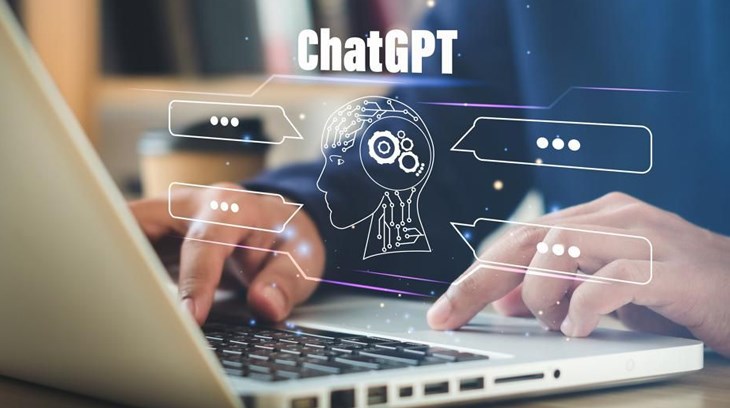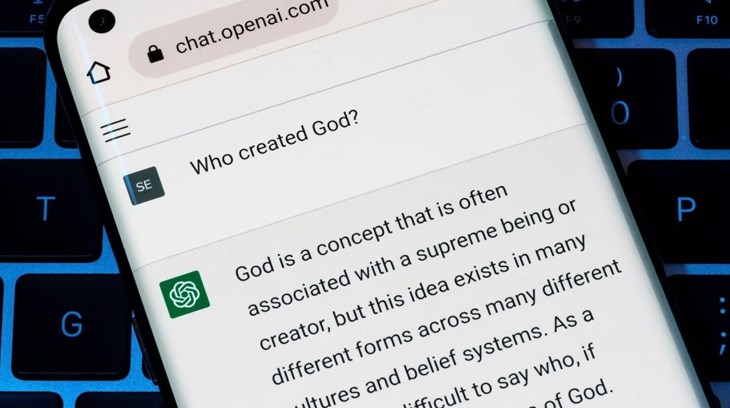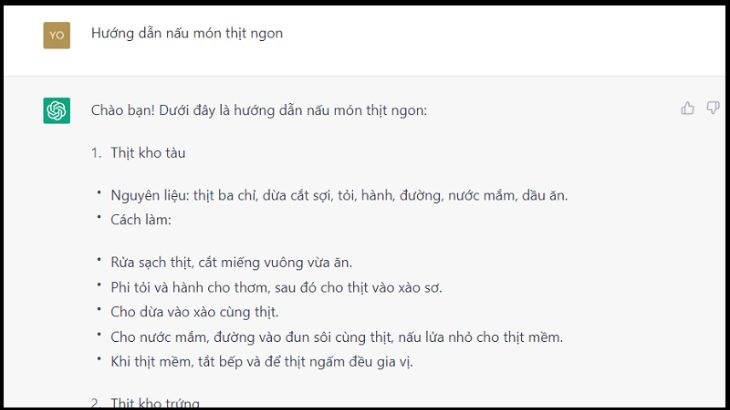1. What is ChatGPT?
ChatGPT (Chat Generative Pre-training Transformer) is a chatbot developed by OpenAI based on Google’s Transformer model. It is an AI (artificial intelligence) that helps create automated conversations and answers questions on a variety of topics and fields.
ChatGPT allows you to engage in human-like conversations, with a special capability to interact in a dialogue format, similar to how two people talk to each other. This feature surprises many users.
ChatGPT creates conversational interactions like chatting with a friend.
-730x410.jpg)
To train GPT, OpenAI researchers collected a massive amount of human-written text from Wikipedia, encyclopedias, major newspapers, and other public information sources—up to hundreds of millions of documents.
They then cleaned and curated the content before feeding it to the AI model for repeated training. By reading this data, the AI learns the layers of meaning behind words and phrases, and the more it reads, the more layers it builds.
ChatGPT synthesizes information from countless sources and explores multiple layers of meaning.

ChatGPT is considered one of the most advanced language models today with the ability to automatically learn and work with large data sets. It features conversational automation, question answering, automatic content creation, and continuous self-learning improvement.
ChatGPT answers questions fluently and in detail in just seconds.
ChatGPT answers questions fluently and in detail in just seconds.
It handles creative and artistic tasks like writing poetry, composing music, drafting letters, designing, and even creating or debugging code.
ChatGPT can “communicate” fluently across various fields.

2. How does ChatGPT work?
ChatGPT was fine-tuned from GPT-3.5 (and now GPT-4), a language model that generates text. It’s optimized for dialogue using Reinforcement Learning from Human Feedback (RLHF)—a method that uses human examples to guide the model toward desired behaviors.
ChatGPT uses infrastructure and internet-based data, raising its storage capacity to 570 GB with 300 billion words integrated into the system. Simply put:
If you ask a question like “How many months are in a year?” and the model responds incorrectly, the correct answer is immediately updated. These small experiments help strengthen the system and improve its accuracy.
ChatGPT’s operating structure is incredibly complex.
-730x410.jpg)
3. What is ChatGPT used for?
Some applications of ChatGPT include:
-
Humanizing conversations: Designed to understand communication and engage in human-like conversation, making it more interactive and personalized than traditional search engines.
-
In-depth answers: While Google provides quick factual answers, ChatGPT offers deeper, easier-to-understand explanations of complex topics.
-
Suggestions: It can make recommendations based on user preferences and interests—especially useful for finding books or movies.
-
Creative content generation: Supports creative work like poetry, storytelling, music composition, graphic design, architecture, etc.
-
Language learning support: Helps learn foreign languages by conversing in the chosen language, providing grammar lessons, vocabulary, and feedback.
-
Translation: Can translate in real-time, allowing communication between speakers of different languages via chat.
-
Medical diagnostics assistance: Can ask relevant questions, provide detailed information, and suggest options based on symptoms and medical history.
-
Entertainment: Offers games, jokes, or puzzles for relaxation and fun.
You can even ask ChatGPT for cooking recipes.

4. Is ChatGPT available in Vietnam?
Yes, ChatGPT officially launched in Vietnam on November 2, 2023. You can register and use ChatGPT for free via the website chat.openai.com or the ChatGPT app on Android and iOS.
Download ChatGPT App:
-
Android
-
iOS
You can easily upgrade to ChatGPT Plus for 475,000 VND/month through the website or app. Payment methods such as Momo, ZaloPay, bank cards, and credit cards are accepted.
ChatGPT has been available in Vietnam with the Plus version since 11/2.
-730x410.jpg)
5. Features of ChatGPT
Benefits:
-
Deployment across platforms: Available on web, mobile, and more.
-
Multilingual support: Trained on multiple languages, serving users globally.
-
Answering diverse questions: Covers a wide range of topics from knowledge, geography, history, economics, politics, culture, etc.
-
Automatic content creation: For writing, storytelling, and other types of content.
-
Customer service: Solves issues quickly and improves service quality.
-
Automation: Increases productivity and efficiency for businesses and organizations.
-
Data analysis and statistics: Helps manage and improve operations effectively.
-
Enhanced user experience: Provides accurate, fast information.
ChatGPT can explain concepts for different contexts and age groups.
-730x410.jpg)
Limitations:
-
Scam software: Some users misuse ChatGPT to create fake software and commit cybercrimes.
-
Inaccuracy: Despite training on large datasets, it can still be incorrect.
-
Misinformation: May distort facts, especially with outdated or inaccurate data.
-
Creativity hindrance: Over-reliance might reduce human creativity.
-
Information search interference: Users may skip natural information-seeking.
-
Job displacement: Potential threat to writers, developers, editors, screenwriters, designers, etc.
Always verify information when using ChatGPT.
-730x410.jpg)
6. How is ChatGPT different from other chatbots?
Tools like Google Bard, Gemini AI, Copilot, etc., respond by indexing web pages to help users find information.
ChatGPT does not search the internet for information.
Instead, it draws on what it learned during training. This can lead to errors or less-than-perfect accuracy.
Another key difference is that ChatGPT is trained to understand user intent and respond helpfully and honestly.
7. Negative impacts of ChatGPT on life
While ChatGPT and large language models bring benefits, they also pose risks:
-
Misinformation: It may generate false or misleading information.
-
Plagiarism concerns: Easily misused by students to do assignments without understanding.
-
Bias and discrimination: Can reproduce societal biases from its training data.
-
Job losses: Could replace roles in writing, translation, and data entry.
-
Abuse: Used for fake news, propaganda, scams, etc.
-
Lack of deep understanding: Doesn’t possess real-world knowledge or emotions.
-
Hard to trace content origin: AI-generated content is hard to distinguish from human content.
-
Security and privacy risks: Data used in training or conversation may be vulnerable.
Responsible use and awareness of limitations are essential.


